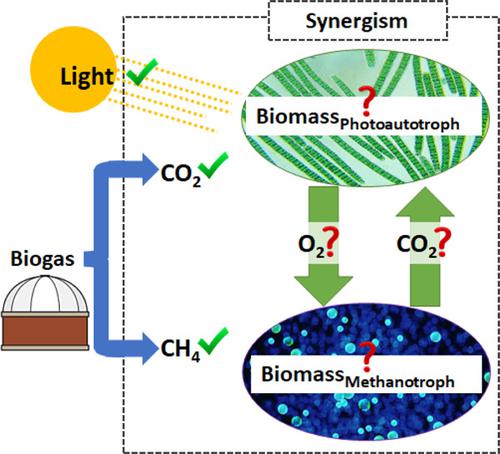当前位置:
X-MOL 学术
›
Biotechnol. Bioeng.
›
论文详情
Our official English website, www.x-mol.net, welcomes your
feedback! (Note: you will need to create a separate account there.)
Fast and easy quantitative characterization of methanotroph–photoautotroph cocultures
Biotechnology and Bioengineering ( IF 3.5 ) Pub Date : 2020-10-16 , DOI: 10.1002/bit.27603 Kiumars Badr 1 , William Whelan 1 , Q Peter He 1 , Jin Wang 1
Biotechnology and Bioengineering ( IF 3.5 ) Pub Date : 2020-10-16 , DOI: 10.1002/bit.27603 Kiumars Badr 1 , William Whelan 1 , Q Peter He 1 , Jin Wang 1
Affiliation

|
Recent research has demonstrated that synthetic methanotroph–photoautotroph cocultures offer a highly promising route to convert biogas into value‐added products. However, there is a lack of techniques for fast and accurate characterization of cocultures, such as determining the individual biomass concentration of each organism in real‐time. To address this unsolved challenge, we propose an experimental–computational protocol for fast, easy, and accurate quantitative characterization of the methanotroph–photoautotroph cocultures. Besides determining the individual biomass concentration of each organism in the coculture, the protocol can also obtain the individual consumption and production rates of O2 and CO2 for the methanotroph and photoautotroph, respectively. The accuracy and effectiveness of the proposed protocol was demonstrated using two model coculture pairs, Methylomicrobium alcaliphilum 20ZR–Synechococcus sp. PCC7002 that prefers high pH high salt condition, and Methylococcus capsulatus–Chlorella sorokiniana that prefers low salt and neutral pH medium. The performance of the proposed protocol was compared with a flow cytometry‐based cell counting approach. The experimental results show that the proposed protocol is much easier to carry out and delivers faster and more accurate results in measuring individual biomass concentration than the cell counting approach without requiring any special equipment.
中文翻译:

甲烷氧化菌-光合自养共培养物的快速简便定量表征
最近的研究表明,合成甲烷氧化菌-光合自养生物共培养为将沼气转化为增值产品提供了一条非常有前景的途径。然而,缺乏快速准确表征共培养物的技术,例如实时确定每个生物体的个体生物量浓度。为了解决这个未解决的挑战,我们提出了一种实验-计算协议,用于快速、简单和准确地定量表征甲烷氧化菌-光合自养共培养物。除了确定共培养中每个生物的个体生物量浓度外,该协议还可以获得 O 2和 CO 2的个体消耗和生产率分别为甲烷氧化菌和光合自养生物。使用两个模型共培养对证明了所提议方案的准确性和有效性,Methylomicrobium alcaliphilum 20ZR– Synechococcus sp。PCC7002,喜高pH高盐条件下,和甲基球菌荚膜-小球藻sorokiniana该更喜欢低盐和中性pH平台。将所提出的协议的性能与基于流式细胞术的细胞计数方法进行了比较。实验结果表明, 与细胞计数方法相比, 所提出的协议更容易执行, 并在测量个体生物量浓度方面提供更快、更准确的结果, 而不需要任何特殊设备。
更新日期:2020-10-16
中文翻译:

甲烷氧化菌-光合自养共培养物的快速简便定量表征
最近的研究表明,合成甲烷氧化菌-光合自养生物共培养为将沼气转化为增值产品提供了一条非常有前景的途径。然而,缺乏快速准确表征共培养物的技术,例如实时确定每个生物体的个体生物量浓度。为了解决这个未解决的挑战,我们提出了一种实验-计算协议,用于快速、简单和准确地定量表征甲烷氧化菌-光合自养共培养物。除了确定共培养中每个生物的个体生物量浓度外,该协议还可以获得 O 2和 CO 2的个体消耗和生产率分别为甲烷氧化菌和光合自养生物。使用两个模型共培养对证明了所提议方案的准确性和有效性,Methylomicrobium alcaliphilum 20ZR– Synechococcus sp。PCC7002,喜高pH高盐条件下,和甲基球菌荚膜-小球藻sorokiniana该更喜欢低盐和中性pH平台。将所提出的协议的性能与基于流式细胞术的细胞计数方法进行了比较。实验结果表明, 与细胞计数方法相比, 所提出的协议更容易执行, 并在测量个体生物量浓度方面提供更快、更准确的结果, 而不需要任何特殊设备。































 京公网安备 11010802027423号
京公网安备 11010802027423号